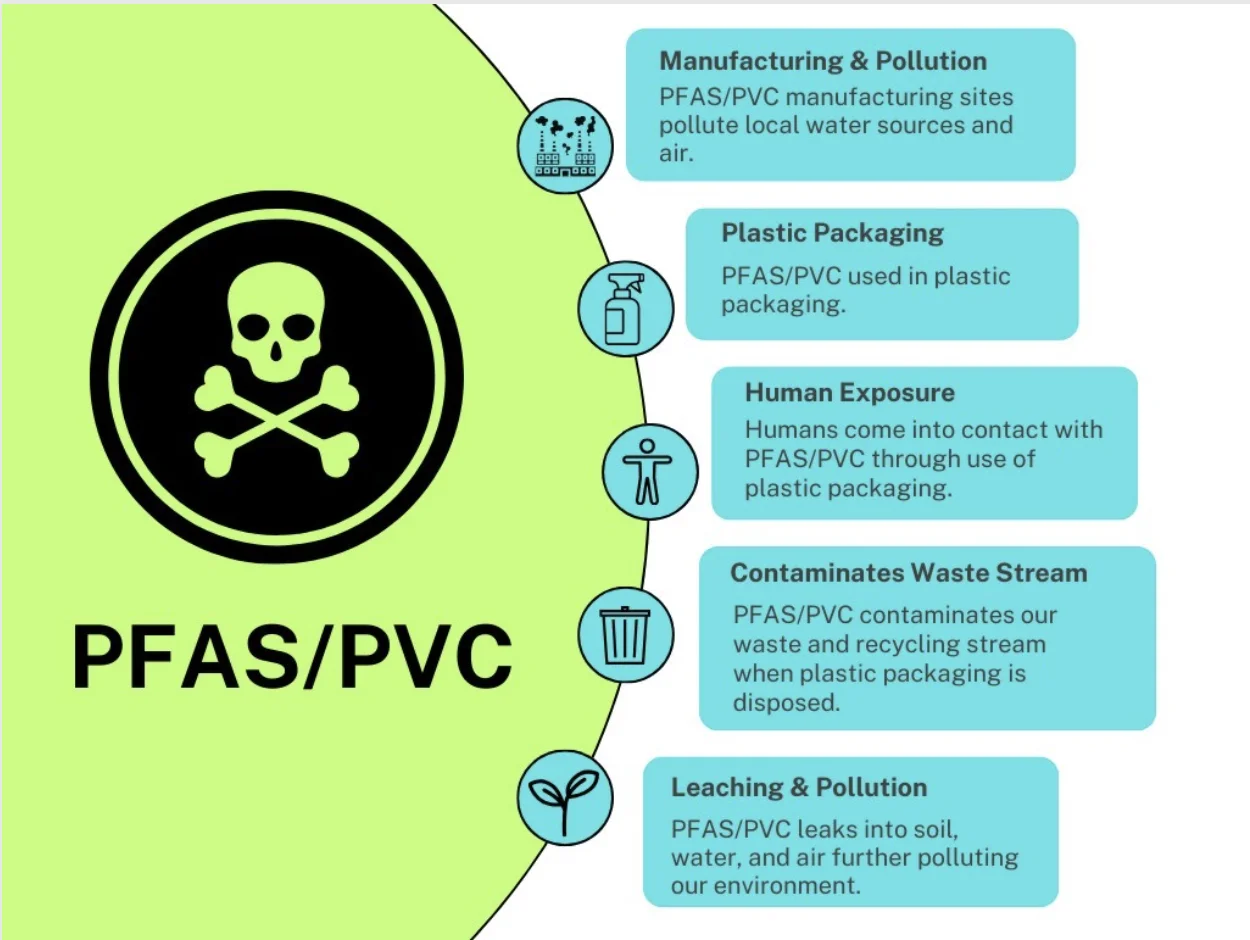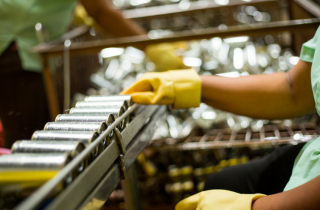Phasing Out Unnecessary Uses of PFAS Act of 2025: CA SB 682
At a Glance
The Phasing Out Unnecessary Uses of PFAS “Forever Chemicals” Act (SB 682- Allen), co-sponsored by Breast Cancer Prevention Partners, would ban the unnecessary use of PFAS ‘forever’ toxic chemicals in several consumer product categories in California, namely cleaning products, dental floss, juvenile products, food packaging, and ski wax by 2028, and cookware by 2030.
PFAS ‘forever’ chemicals are a class of over 12,000 persistent hazardous chemicals linked to many serious health problems, including breast and other cancers, birth defects, hormone disruption, kidney and liver damage, and thyroid disease. PFAS are known as ‘forever chemicals’ because they don’t break down for centuries. They build up in our bodies and the environment, endangering us and future generations.
Status: Passed CA Senate (28 to 7, 5 not voting), passed the Assembly Committee on Environmental Safety and Toxic Materials (5 to 2, 2 not voting).
Passed Assembly Floor vote on Sept 12. Unfortunately, despite passing the entire California Legislature, the Governor decided to veto this bill. See our statement here:
BCPP Statement on the Veto of AB 823 and SB 682 – Breast Cancer Prevention Partners (BCPP)

Key Facts about PFAS in Our Products:
- PFAS are widely used in a range of consumer products, leading to widespread contamination of food, water, soil, workplaces, and people’s bodies.
- Products containing PFAS pollute people and the planet during their production, use, and disposal.
- A 2020 study found PFAS are used in almost all industries and over 200 consumer product categories, including textiles, fire-fighting foam, food packaging, juvenile products, beauty and personal care product, dental floss, optical devices (contact lenses), ski wax, climbing ropes, guitar strings, coatings, paints and varnishes, music instruments, pesticides, and artificial turf.[1]
- With few exceptions, manufacturers are not required to disclose the presence of PFAS in their products, leaving consumers unaware of where their exposures are coming from.
- Since 2020, California has banned PFAS in various consumer products. SB 682 would include six additional product categories already prohibited in other states.
- Disposal of products through recycling, incineration, and landfills result in PFAS chemicals being released into the environment: seeping into groundwater and soil, contaminating drinking water, and entering the atmosphere. Contamination generated from these methods of disposal disproportionately impacts communities already burdened by environmental injustice and adds to the global burden of these forever chemicals.
- PFAS can build up in our bodies. Based on CDC biomonitoring work, it is estimated that over 98% of Americans have PFAS in their blood. PFAS can be transferred from mothers to their babies through the placenta before birth and through breast milk after birth.
- PFAS chemicals disrupt our immune systems, increasing our risk for COVID and reducing the health protective effect of vaccines. Studies show PFAS chemicals are linked to decreased antibody response to vaccines.
- A study in 2019 estimated the direct annual health care costs of the impacts of exposure to PFAS in Europe as 52-84 billion Euros. A 2021 article published by leading scientists noted that the equivalent annual direct health-related costs in the United States would be $37−59 billion annually.[2]
- California has banned the use of PFAS in various consumer products including textiles (clothing, outdoor gear, accessories, and home furnishing textiles, AB 1817, 2023); paper-based food packaging (AB 1200, 2022); personal care and beauty products (AB 2771, 2022; AB 2762, 2020); certain juvenile products (AB 652, 2021); and fire-fighting foam (SB 1044 2020).
- The Phasing Out Unnecessary Uses of PFAS “Forever Chemicals” Act (SB 682) would add cookware, cleaning products, dental floss, and ski wax, and include a broader scope of products under the juvenile products and food packaging categories, going beyond existing bans.
- Safer alternatives for many consumer uses already exist, as demonstrated by the numerous companies that have stopped using PFAS, including for all of the products covered by SB 682.
Related Resources
Co-Sponsoring Organizations
- Breast Cancer Prevention Partners
- California Association of Sanitation Agencies
- Clean Water Action
- Environmental Working Group
- Natural Resources Defense Council
Supporting Organizations
A Voice for Choice Advocacy
Alliance of Nurses for Healthy Environments
American College of Ob-gyn’s District Ix
American Sustainable Business Network
Association of California Water Agencies
Azul
Bay Area Clean Water Agencies
California Casa
California Health Coalition Advocacy
California Product Stewardship Council
California Professional Firefighters
California Safe Schools Coalition
California Stormwater Quality Association
Californians Against Waste
Calpirg
Center for Community Action and Environmental Justice
Center for Environmental Health
Center for Public Environmental Oversight
Central Contra Costa Sanitary District
City of Roseville
City of Thousand Oaks
Cleanearth4kids.org
Climate Reality Project San Diego
Climate Reality Project San Fernando Valley Chapter
Climate Reality Project, Los Angeles Chapter
Climate Reality Project, Orange County
Coalition for Clean Air
Community Water Center Dublin
San Ramon Services District SB 682
East Bay Dischargers Authority
East Valley Water District
Eastern Municipal Water District
Educate. Advocate.
El Granada Advocates
Elsinore Valley Municipal Water District
Environmental Defense Fund
Erin Brockovich Foundation
Facts Families Advocating for Chemical and Toxics Safety
Fairfield-suisun Sewer District
Go Green Initiative
Green Science Policy Institute
Inland Empire Utilities Agency
Integrated Resource Management
Jurupa Community Services District
Las Virgenes Municipal Water District
Leadership Counsel Action
League of California Cities
Los Angeles County Sanitation Districts
Los Angeles Waterkeeper
Monterey One Water
National Stewardship Action Council
Non-toxic Neighborhoods
Orange County Sanitation District
Physicians for Social Responsibility-los Angeles
Rancho California Water District
Recolte Energy Resource
Renewal Institute
Responsible Purchasing Network
Rethink Disposable
San Francisco Bay Area Physicians for Social Responsibility
San Francisco Baykeeper
Save the Bay
Sierra Club
Sierra Club California
Silicon Valley Clean Water Socal 350 Climate Action
Story of Stuff
Vallejo Flood and Wastewater District
Valley Sanitary District (UNREG)
Water Replenishment District of Southern California
Watereuse California
Western Municipal Water District
Footnotes
[1] Glüge, J.; Scheringer, M.; Cousins, I. T.; DeWitt, J. C.; Goldenman, G.; Herzke, D.; Lohmann, R.; Ng, C. A.; Trier, X.; Zhanyun, W. An overview of the uses of per-and polyfluoroalkyl substances (PFAS). Environ. Science: Process. Impacts 2020, 22, 2345−2373. DOI: 10.1039/d0em00291g https://pubmed.ncbi.nlm.nih.gov/33125022/
[2] Cordner et al, The True Cost of PFAS and the Benefits of Acting Now, Environ. Sci. Technol. 2021, 55, 9630−9633 https://pubs.acs.org/doi/10.1021/acs.est.1c03565
Types: Article, Fact Sheet




